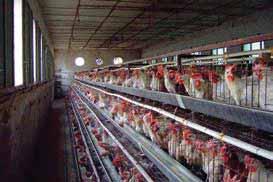
2 minute read
Climate management in high temperatures
Climate management in high temperatures
The optimum house temperature for laying hens is about 25°C. Up to a temperature of about 30°C you will notice that the hen can still regulate her own temperature reasonably well. Above that you will need to provide cooling. A desert cooler can lower the indoor temperature quite significantly when the outside air is hot and dry. Make sure the incoming cooled air is not directed straight onto the birds. If there is no cooling facility, ventilation can help prevent heat stress. Chickens cool themselves down by evaporating moisture by panting. When chickens pant, the air around the head contains high levels of moisture. It is important to get rid of this air as quickly as possible so that more moist air can be given off. A few extra fans that provide more air movement and are directed at the birds are an effective way of dealing with high temperatures. You should see the feathers moving in the airflow. As they can’t sweat, excessive cooling won’t affect the birds as long as the air temperature is higher than 26°C.
Advertisement
If it gets warmer or too warm, in floor housing you will notice that the birds are dust bathing more, ruffling their feathers and spreading their wings. Birds in a cage system are not able to do this, but they pant with their beaks open and spread out their wings. It is important to make sure that every bird in every cage has the best possible ventilation. In intensive sunshine the roof of the poultry house can get very hot and the incoming air around the house can heat up to quite a high level. Spraying the roof creates a lot of condensation which cools it down. Atomisers installed under the roof of the house can also provide These windows can be opened, but they can cause some cooling through humidification. But only when the draughts and can only be open or closed. There is little relative humidity is not too high. control.

copyright protected


Provision for cool nights
In tropical regions the outside temperature can often drop well below 25°C at night, and even to around freezing point. In open sided poultry houses you will therefore need to close the curtains at night. In this photo you can see that these curtains can be pulled up. The cold air flow should not be directed at the birds. Birds in a strong current of air below 25°C can suffer from problems with colds (mucous) and sometimes coryza. In mechanically ventilated poultry houses, air inlets should be designed in such a way that the incoming air is directed to the ridge of the house where it will be mixed with the warm indoor air.










